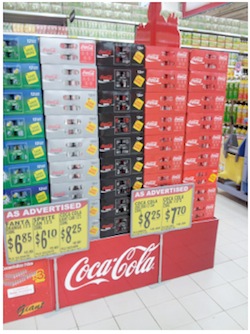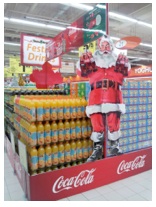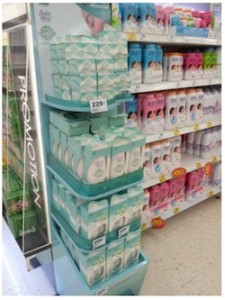I like going to grocery stores. Luckily enough as part of my career at engage, I have opportunities to travel around Asia and visit different types of stores in different markets, from little mom and pop shops in Colombo to big hypermarkets in Seoul. Every store, regardless of location and store classification, shares one simple goal – ensuring there are shoppers in stores, picking up products and making purchases. Likewise, all manufacturers have similar desire – making sure products being bought are THEIRS! A question to all manufacturers out there – are you making it easy for shoppers to buy your brands?
Some products are difficult to buy
 Let’s think about this image taken from a hypermarket in Singapore. I ran into this big display of 12-can packs. It looked impressive and you cannot miss it but one important question – is it easy for shoppers to buy?
Let’s think about this image taken from a hypermarket in Singapore. I ran into this big display of 12-can packs. It looked impressive and you cannot miss it but one important question – is it easy for shoppers to buy?
Let’s pause and think for a second. Assuming many shoppers are female, housewives shopping alone for their families. 12-can packs are heavy and an average Singaporean woman stands 160 cm (or less). Imagine yourself standing there in front of the display.  You would have to stand on to reach to the top to grab one. That’s a bit of a sweat and I speak from personal experience as an average-built Asian woman myself. Mr. Smiley Santa cannot help you in this case.
You would have to stand on to reach to the top to grab one. That’s a bit of a sweat and I speak from personal experience as an average-built Asian woman myself. Mr. Smiley Santa cannot help you in this case.
The role of in-store marketing
I give 10 points for creating desired shopping behavior through this execution – buying big volume for parties and gatherings during a festive period, which ultimately turns into big consumption. That is what in-store marketing should do: create purchase behaviors that are translated into consumption of the brand. There are 3 elements of in-store marketing – availability, communication and offer, and very often one element is tied up into another.
Is your product available in-store?
Arguably this is the most important element. Shoppers cannot buy your brand if it is not there on the shelf. Availability also means visibility. Is it easy for shopper to see your brand? Is it in the right location where it can be found? Let’s look at this new range of baby moisturizer and baby cream from a hypermarket in Thailand. It is a gondola display in a baby section so moms cannot miss it. Tick a box for availability.
Are we communicating enough in-store?
 Communication is about sending a message to shoppers and the media that would help you to do so. It is about telling people why your brands should be selected. It is about addressing barriers to buy your brands and the latter is sometimes forgotten. The brand in the previous picture recently launched their premium segment ‘Ultra Mild’ with organic ingredients, which of course, is gentler and milder for your baby’s skin. What is interesting about this is that, apart from telling moms that this is moisturizer, there is no message telling mothers why they need this. Why do I think a ‘message’ is important? Well, the product is two times more expensive than other ‘ordinary’ mild variants.
Communication is about sending a message to shoppers and the media that would help you to do so. It is about telling people why your brands should be selected. It is about addressing barriers to buy your brands and the latter is sometimes forgotten. The brand in the previous picture recently launched their premium segment ‘Ultra Mild’ with organic ingredients, which of course, is gentler and milder for your baby’s skin. What is interesting about this is that, apart from telling moms that this is moisturizer, there is no message telling mothers why they need this. Why do I think a ‘message’ is important? Well, the product is two times more expensive than other ‘ordinary’ mild variants.
Offer
Offer is about the standard retail price of your products. It also includes other promotional mechanics that you choose to apply – price promotion, buy one get one free or extra volume at the same price. But as I mentioned earlier, you need to consider all elements of in-store marketing in your execution. The previous example of the baby product is a new range. Their strategy must be either to attract new shoppers (first-time buying moms) or to trade up existing shoppers (moms currently buying standard ranges for their babies). Price is an obvious barrier for both. We all know that shoppers often compare price, especially when the regular products are a few steps away. There is no communication of additional benefits to justify higher price of this premium range. In fact, there is no communication that it is a ‘premium’. Unless moms are educated and strongly make up their minds before coming to the store to buy it, getting impulse purchase of the brands could be challenging.
Think like a shopper
Looking at planograms on a computer screen is not enough. It may look impressive on your PC but do not forget to go to the store and see the ‘real action’. Be a shopper. Put yourself in shoppers’ shoes. Look at your brand execution and think through all the three elements of in-store marketing – availability, communication, and offer. The end purpose of every execution is to get shoppers to buy YOUR brand. Let’s make it easy for shoppers to decide.
If you want to learn more about how in-store marketing can leverage your in-store execution, feel free to contact our engage team!

